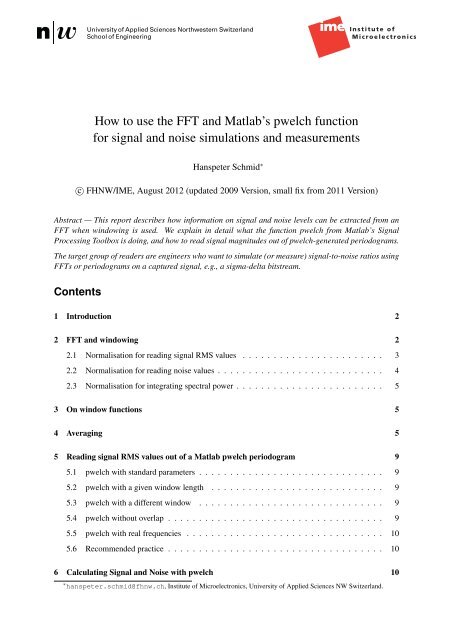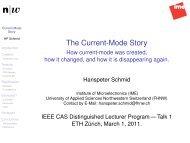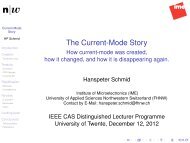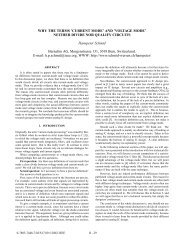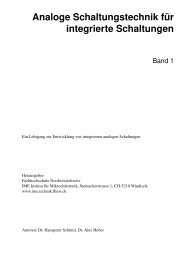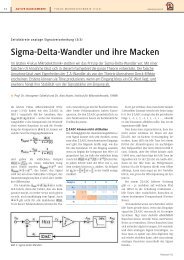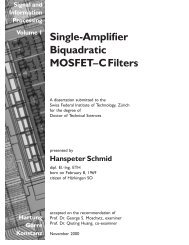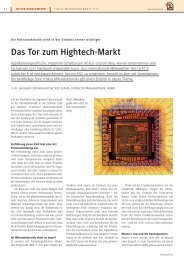How to use the FFT and Matlab's pwelch function for signal and ...
How to use the FFT and Matlab's pwelch function for signal and ...
How to use the FFT and Matlab's pwelch function for signal and ...
Create successful ePaper yourself
Turn your PDF publications into a flip-book with our unique Google optimized e-Paper software.
<strong>How</strong> <strong>to</strong> <strong>use</strong> <strong>the</strong> <strong>FFT</strong> <strong>and</strong> Matlab’s <strong>pwelch</strong> <strong>function</strong><br />
<strong>for</strong> <strong>signal</strong> <strong>and</strong> noise simulations <strong>and</strong> measurements<br />
Hanspeter Schmid ∗<br />
c○ FHNW/IME, August 2012 (updated 2009 Version, small fix from 2011 Version)<br />
Abstract — This report describes how in<strong>for</strong>mation on <strong>signal</strong> <strong>and</strong> noise levels can be extracted from an<br />
<strong>FFT</strong> when windowing is <strong>use</strong>d. We explain in detail what <strong>the</strong> <strong>function</strong> <strong>pwelch</strong> from Matlab’s Signal<br />
Processing Toolbox is doing, <strong>and</strong> how <strong>to</strong> read <strong>signal</strong> magnitudes out of <strong>pwelch</strong>-generated periodograms.<br />
The target group of readers are engineers who want <strong>to</strong> simulate (or measure) <strong>signal</strong>-<strong>to</strong>-noise ratios using<br />
<strong>FFT</strong>s or periodograms on a captured <strong>signal</strong>, e.g., a sigma-delta bitstream.<br />
Contents<br />
1 Introduction 2<br />
2 <strong>FFT</strong> <strong>and</strong> windowing 2<br />
2.1 Normalisation <strong>for</strong> reading <strong>signal</strong> RMS values . . . . . . . . . . . . . . . . . . . . . . . 3<br />
2.2 Normalisation <strong>for</strong> reading noise values . . . . . . . . . . . . . . . . . . . . . . . . . . . 4<br />
2.3 Normalisation <strong>for</strong> integrating spectral power . . . . . . . . . . . . . . . . . . . . . . . . 5<br />
3 On window <strong>function</strong>s 5<br />
4 Averaging 5<br />
5 Reading <strong>signal</strong> RMS values out of a Matlab <strong>pwelch</strong> periodogram 9<br />
5.1 <strong>pwelch</strong> with st<strong>and</strong>ard parameters . . . . . . . . . . . . . . . . . . . . . . . . . . . . . . 9<br />
5.2 <strong>pwelch</strong> with a given window length . . . . . . . . . . . . . . . . . . . . . . . . . . . . 9<br />
5.3 <strong>pwelch</strong> with a different window . . . . . . . . . . . . . . . . . . . . . . . . . . . . . . 9<br />
5.4 <strong>pwelch</strong> without overlap . . . . . . . . . . . . . . . . . . . . . . . . . . . . . . . . . . . 9<br />
5.5 <strong>pwelch</strong> with real frequencies . . . . . . . . . . . . . . . . . . . . . . . . . . . . . . . . 10<br />
5.6 Recommended practice . . . . . . . . . . . . . . . . . . . . . . . . . . . . . . . . . . . 10<br />
6 Calculating Signal <strong>and</strong> Noise with <strong>pwelch</strong> 10<br />
∗ hanspeter.schmid@fhnw.ch, Institute of Microelectronics, University of Applied Sciences NW Switzerl<strong>and</strong>.
2 2 <strong>FFT</strong> AND WINDOWING<br />
Figure 1: The same sum of white noise added <strong>to</strong> an sine <strong>function</strong> <strong>for</strong> two different simulation times.<br />
1 Introduction<br />
Simulating (or measuring) <strong>signal</strong>s <strong>and</strong> noise with an <strong>FFT</strong> is not trivial, beca<strong>use</strong> <strong>signal</strong>s <strong>and</strong> noise do not<br />
behave in <strong>the</strong> same way when plotted as a power spectrum using an <strong>FFT</strong>.<br />
This phenomenon can be explained intuitively: Let us do <strong>the</strong> following thought experiment: we <strong>use</strong> a<br />
sine <strong>signal</strong> of frequency 100 Hz <strong>and</strong> amplitude √ 2 <strong>and</strong> a white noise source with power spectral density<br />
10 −8 over <strong>the</strong> whole frequency range covered by <strong>the</strong> <strong>FFT</strong>. 1 What happens if <strong>the</strong> simulation 2 time is<br />
increased by a fac<strong>to</strong>r of 100, but <strong>the</strong> sampling time is left <strong>the</strong> same?<br />
The answer directly follows from Parceval’s Theorem that states: <strong>the</strong> <strong>to</strong>tal <strong>signal</strong> power in <strong>the</strong> time<br />
domain <strong>and</strong> in <strong>the</strong> frequency domain is <strong>the</strong> same. If we just increase <strong>the</strong> simulation time, <strong>the</strong>n <strong>the</strong> <strong>signal</strong><br />
power does not change, so <strong>the</strong> amplitude of <strong>the</strong> <strong>signal</strong> stays <strong>the</strong> same. The noise power also does not<br />
change, but it is white noise, <strong>and</strong> occurs in all frequency bins of <strong>the</strong> <strong>FFT</strong>. We now have 100 times as<br />
many frequency bins as be<strong>for</strong>e, so we have <strong>to</strong> expect that <strong>the</strong> <strong>signal</strong> power within one frequency bin is<br />
diminished by a fac<strong>to</strong>r of 100, or 20 dB. Figure 1 shows <strong>the</strong>se two simulations next <strong>to</strong> each o<strong>the</strong>r. The<br />
20 dB difference is well visible.<br />
To see this in simulation is not trivial, <strong>for</strong> two reasons: first, <strong>the</strong> <strong>FFT</strong> itself also introduces a fac<strong>to</strong>r N,<br />
<strong>the</strong> length of <strong>the</strong> <strong>FFT</strong>, <strong>and</strong> second, as can be seen in <strong>the</strong> left plot of Fig. 1, <strong>the</strong> <strong>signal</strong> may obfuscate <strong>the</strong><br />
noise beca<strong>use</strong> it is smeared out. The latter effect can be fought with windowing.<br />
2 <strong>FFT</strong> <strong>and</strong> windowing<br />
Windowing means that <strong>the</strong> time series <strong>to</strong> be trans<strong>for</strong>med is multiplied by a window <strong>function</strong> be<strong>for</strong>e <strong>the</strong><br />
<strong>FFT</strong> is done. So instead of x[i], we trans<strong>for</strong>m x[i]w[i] <strong>for</strong> some window <strong>function</strong> which promises <strong>to</strong><br />
produce a clearer spectral representation of <strong>the</strong> <strong>signal</strong>.<br />
Like <strong>the</strong> <strong>FFT</strong> itself, <strong>the</strong> window also affects <strong>signal</strong>s <strong>and</strong> noise in different ways. A wealth of details on<br />
windowing can be found in [1]; here we just give an intuitive explanation: every single frequency bin of<br />
<strong>the</strong> trans<strong>for</strong>med <strong>signal</strong> is a linear combination of N time samples. If <strong>the</strong> <strong>signal</strong> <strong>to</strong> be trans<strong>for</strong>med is a<br />
sine <strong>function</strong>, <strong>the</strong>n, ideally, all <strong>the</strong>se N samples add up in one bin <strong>and</strong> cancel out in all o<strong>the</strong>r bins, such<br />
1 In Matlab Simulink, this would be a “Sine Wave” block with amplitude √ 2 <strong>and</strong> frequency 2π100 rad/sec; <strong>and</strong> a “B<strong>and</strong><br />
Limited White Noise” block with noise power 10 −8 /2. The reason <strong>for</strong> <strong>the</strong> ·/2 is that we want <strong>to</strong> have a one-sided power<br />
spectral density (PSD) of 10 −8 , but <strong>the</strong> Simulink block “B<strong>and</strong> Limited White Noise” assumes a two-sided PSD.<br />
2 All of this is also valid <strong>for</strong> measurements.<br />
c○ 2012 FHNW/IME
2.1 Normalisation <strong>for</strong> reading <strong>signal</strong> RMS values 3<br />
Window CG NG Scallop Loss<br />
Rectangular 1.0000 1.0000 3.92 dB<br />
Hamming 0.5400 0.3974 1.78 dB<br />
Hanning 0.5000 0.3750 1.42 dB<br />
Bartlett 0.5000 0.3333 —<br />
Blackman-Harris 0.3587 0.2580 0.83 dB<br />
Flat Top 0.2156 0.1752 —<br />
Table 1: Correction fac<strong>to</strong>rs <strong>and</strong> maximum scallop loss <strong>for</strong> different window types (only exact <strong>for</strong> large<br />
window lengths N).<br />
that <strong>the</strong> sine will result in a single peak in <strong>the</strong> spectrum. For x[i]w[i], <strong>the</strong> average value in <strong>the</strong> bin where<br />
<strong>the</strong> time <strong>signal</strong>s add up will <strong>the</strong>re<strong>for</strong>e be multiplied by<br />
CG = 1 N<br />
N−1<br />
∑<br />
i=0<br />
w[i] (1)<br />
compared <strong>to</strong> what happens when a rectangular window (w[i] = 1 <strong>for</strong> all i) is <strong>use</strong>d. CG is <strong>the</strong> coherent<br />
gain of <strong>the</strong> window. If <strong>the</strong> <strong>signal</strong> is white noise, however, <strong>the</strong>n <strong>the</strong> N time samples are uncorrelated. This<br />
means that in every bin, <strong>the</strong> noise power of N input values will add up, <strong>and</strong> <strong>the</strong> average value in <strong>the</strong> bin<br />
will be<br />
NG = 1 N<br />
N−1<br />
∑<br />
i=0<br />
w[i] 2 (2)<br />
compared <strong>to</strong> what happens when a rectangular window is <strong>use</strong>d. We call NG <strong>the</strong> noise gain. For a<br />
rectangular window, CG = NG = 1. For reference purposes, <strong>the</strong> correction fac<strong>to</strong>rs <strong>and</strong> <strong>the</strong> scallop loss<br />
(see Sec. 3) of a few common windows are listed in Table 1.<br />
There are three ways <strong>to</strong> normalise <strong>the</strong> resulting spectrum, depending on how one wants <strong>to</strong> <strong>use</strong> <strong>the</strong> PSD:<br />
first, <strong>to</strong> read <strong>signal</strong> values directly off <strong>the</strong> plot; second, <strong>to</strong> read <strong>the</strong> noise power spectral density directly<br />
off <strong>the</strong> plot; <strong>and</strong> third, <strong>to</strong> quantitatively determine <strong>the</strong> power in any frequency b<strong>and</strong> by adding <strong>the</strong> values<br />
of all bins in that b<strong>and</strong>.<br />
Note that <strong>the</strong> third method will always give <strong>the</strong> most precise numbers; <strong>the</strong> first two methods are only<br />
<strong>use</strong>ful <strong>for</strong> documentation! Un<strong>for</strong>tunately, Matlab’s <strong>pwelch</strong> <strong>function</strong> returns a spectrum of <strong>the</strong> second<br />
type, as described below.<br />
2.1 Normalisation <strong>for</strong> reading <strong>signal</strong> RMS values<br />
If we want <strong>to</strong> be able <strong>to</strong> read <strong>the</strong> RMS value of deterministic <strong>signal</strong>s from an <strong>FFT</strong> plot, we have <strong>to</strong> divide<br />
<strong>the</strong> <strong>FFT</strong> by N times <strong>the</strong> coherent gain <strong>and</strong> <strong>the</strong>n calculate <strong>the</strong> power spectral density. So <strong>for</strong> an input<br />
<strong>signal</strong> x, we get <strong>for</strong> <strong>the</strong> one-sided power spectral density:<br />
Y [i] =<br />
<strong>FFT</strong> {x[i]w[i]}<br />
N · CG<br />
, (3)<br />
P yy [0] = Y [0] · Y [0] ∗ <strong>and</strong> P yy [i] = 2 · Y [i] · Y [i] ∗ <strong>for</strong> i > 0. (4)<br />
c○ 2012 FHNW/IME
4 2 <strong>FFT</strong> AND WINDOWING<br />
Using this scaling, we can read <strong>the</strong> RMS-value of a deterministic <strong>signal</strong> directly off <strong>the</strong> plot. Note that<br />
this reading will not necessarily be precise; depending on <strong>the</strong> frequency of <strong>the</strong> <strong>signal</strong> relative <strong>to</strong> <strong>the</strong> centre<br />
frequency of <strong>the</strong> bin showing <strong>the</strong> highest value, <strong>and</strong> depending on <strong>the</strong> window <strong>use</strong>d, <strong>the</strong>re can be read-off<br />
errors up <strong>to</strong> several dB. This effect is called scallop loss [1] <strong>and</strong> sometimes also picket fence effect. We<br />
chose <strong>the</strong> <strong>signal</strong> frequencies in this paper such that this does not happen (except in Sec. 6, where we want<br />
<strong>to</strong> demonstrate scallop loss), so <strong>the</strong> 0 dB visible in Fig. 1 correspond <strong>to</strong> 1 V rms , which was <strong>the</strong> value <strong>use</strong>d<br />
in <strong>the</strong> simulation. Note, however, that in a practical measurement one can not <strong>for</strong>ce this situation unless<br />
<strong>the</strong> clock of <strong>the</strong> data acquisition is synchronised <strong>to</strong> <strong>the</strong> <strong>signal</strong> <strong>to</strong> be measured.<br />
<strong>How</strong> can we now read <strong>the</strong> power spectral density of <strong>the</strong> noise <strong>signal</strong> from <strong>the</strong> plot? When white noise<br />
with <strong>the</strong> power spectral density ¯x 2 n is fed in<strong>to</strong> <strong>the</strong> <strong>FFT</strong>, <strong>the</strong>n <strong>the</strong> noise represented by one point of <strong>the</strong> <strong>FFT</strong><br />
will be <strong>the</strong> noise integrated over a frequency range<br />
f bin = 1<br />
T sim<br />
=<br />
1<br />
NT samp<br />
, (5)<br />
(where T sim is <strong>the</strong> simulation or measurement time <strong>and</strong> T samp is <strong>the</strong> sampling period) <strong>and</strong> <strong>the</strong>n multiplied<br />
by <strong>the</strong> noise gain. Since we previously divided <strong>the</strong> result of <strong>the</strong> <strong>FFT</strong> by CG, what we plot actually is<br />
P yy [i] = ¯x 2 n · NG · f bin<br />
CG 2 . (6)<br />
There<strong>for</strong>e <strong>the</strong> power spectral density calculated from <strong>the</strong> value in <strong>the</strong> <strong>FFT</strong> is:<br />
¯x 2 n = P yy[i]CG 2<br />
NGf bin<br />
, (7)<br />
or, in o<strong>the</strong>r words, if we want <strong>to</strong> plot a known power spectral density in<strong>to</strong> a plot generated using (3) <strong>and</strong><br />
(4), we first need <strong>to</strong> scale it by <strong>the</strong> fac<strong>to</strong>r<br />
s n = NGf bin<br />
CG 2 . (8)<br />
The red lines in Figure 1 have been obtained like this. For a rectangular window, <strong>the</strong> calculation is trivial:<br />
since CG = NG = 1, we get s n = f bin .<br />
2.2 Normalisation <strong>for</strong> reading noise values<br />
Sometimes reading <strong>the</strong> noise level off a plot is more important than being able <strong>to</strong> read a <strong>signal</strong>. The same<br />
reasoning as above shows that in this case, <strong>the</strong> proper way <strong>to</strong> normalise <strong>the</strong> <strong>FFT</strong> is<br />
Y [i] = 1 <strong>FFT</strong> {x[i]w[i]} , (9)<br />
N<br />
P yy [0] =<br />
Y [0] · Y [0]∗<br />
2 · Y [i] · Y [i]∗<br />
<strong>and</strong> P yy [i] = <strong>for</strong> i > 0. (10)<br />
NGf bin NGf bin<br />
This is what Matlab’s <strong>pwelch</strong> <strong>function</strong> is doing.<br />
If we <strong>the</strong>n know that <strong>the</strong> power at index i comes from a deterministic <strong>signal</strong>, <strong>the</strong> power of that <strong>signal</strong> is<br />
P sig = P yy [i] · NGf bin<br />
CG 2 . (11)<br />
c○ 2012 FHNW/IME
2.3 Normalisation <strong>for</strong> integrating spectral power 5<br />
2.3 Normalisation <strong>for</strong> integrating spectral power<br />
This case is closely related <strong>to</strong> <strong>the</strong> normalisation <strong>for</strong> reading noise values, only now we want each spectrum<br />
value <strong>to</strong> be <strong>the</strong> power integrated over <strong>the</strong> bin. This is <strong>the</strong> same as above, but without <strong>the</strong> division by<br />
f bin :<br />
Y [i] = 1 <strong>FFT</strong> {x[i]w[i]} , (12)<br />
N<br />
P yy [0] =<br />
Y [0] · Y [0]∗<br />
NG<br />
<strong>and</strong><br />
P yy [i] =<br />
2 · Y [i] · Y [i]∗<br />
NG<br />
<strong>for</strong> i > 0. (13)<br />
Then one can calculate <strong>the</strong> <strong>to</strong>tal power over some frequency range f 1 . . . f 2 as<br />
P 1,2 =<br />
∫ f2<br />
f 1<br />
P ′ yy(f)df ≈<br />
i 2 ∑<br />
i 1<br />
P yy [i] , (14)<br />
where P ′ yy(f) is <strong>the</strong> true spectrum of <strong>the</strong> <strong>signal</strong> observed <strong>and</strong> i 1 , i 2 are <strong>the</strong> indices of <strong>the</strong> bins that contain<br />
<strong>the</strong> frequencies f 1 , f 2 . This means that if one wants <strong>to</strong> integrate over <strong>the</strong> values returned by Matlab’s<br />
<strong>pwelch</strong> <strong>function</strong> <strong>to</strong> calculate <strong>the</strong> power within a frequency range, <strong>the</strong>n <strong>the</strong> <strong>pwelch</strong> spectrum must first be<br />
multiplied by f bin .<br />
3 On window <strong>function</strong>s<br />
Much has been written about window <strong>function</strong>s, <strong>and</strong> using <strong>the</strong> best window <strong>function</strong> <strong>for</strong> a certain application<br />
requires a lot of specialised knowledge. Without going in<strong>to</strong> <strong>the</strong> detail, we recommend <strong>to</strong> <strong>use</strong> <strong>the</strong><br />
Hanning window <strong>for</strong> most applications, except when very low noise has <strong>to</strong> be observed in <strong>the</strong> presence<br />
of a <strong>signal</strong>, <strong>the</strong>n <strong>the</strong> Blackman-Harris window gives better results.<br />
Figures 2 <strong>and</strong> 3 show this. It can be seen in Fig. 3 that <strong>the</strong> Hanning window concentrates <strong>the</strong> <strong>signal</strong><br />
in a narrower peak, but below some value, <strong>the</strong> <strong>signal</strong> is smeared out in<strong>to</strong> so-called side lobes. The<br />
Blackman-Harris window creates a wider peak <strong>to</strong> start with, but has much lower side lobes.<br />
Fig. 2 shows well that using windows is not <strong>for</strong> free, compared <strong>to</strong> <strong>the</strong> Rectangular window, <strong>the</strong>y raise<br />
<strong>the</strong> visible noise floor. In Fig. 2, <strong>the</strong> rectangular window plots <strong>the</strong> white noise at −70 dB, <strong>the</strong> Hanning<br />
window at −68.24 dB, <strong>and</strong> <strong>the</strong> Blackman-Harris window at −66.98 dB. This means that <strong>the</strong> latter is least<br />
suitable when one wants <strong>to</strong> see small dis<strong>to</strong>rtion peaks in <strong>the</strong> noise floor: dis<strong>to</strong>rtion peaks are deterministic<br />
<strong>signal</strong>s <strong>and</strong> will not change <strong>the</strong>ir magnitude in P yy if we apply a different window.<br />
<strong>How</strong>ever, remember <strong>the</strong> beginning of this report: if you want <strong>to</strong> see smaller peaks in <strong>the</strong> noise floor, <strong>the</strong>n<br />
you need not optimise <strong>the</strong> <strong>FFT</strong> window. You just need <strong>to</strong> measure or simulate a longer data sequence!<br />
4 Averaging<br />
One problem of looking at noise with an <strong>FFT</strong> is that <strong>the</strong> obtained spectrum is inherently noisy. In fact,<br />
due <strong>to</strong> Parseval’s <strong>the</strong>orem, <strong>the</strong> variance of <strong>the</strong> spectrum is simply <strong>the</strong> variance of <strong>the</strong> noise, or, in o<strong>the</strong>r<br />
words, σ 2 n = ¯x 2 n.<br />
Looking at any kind of scattered plots, <strong>the</strong>re is a rule of thumb that states: <strong>the</strong> outer edges of <strong>the</strong> scattered<br />
field extend approximately <strong>to</strong> 3σ. This is shown in Fig. 4. It means that <strong>the</strong> upper visual edge of a noise<br />
spectrum is always at (¯x n + 3σ n ) 2 = (4¯x n ) 2 , which are 6 dB above ¯x 2 n in <strong>the</strong> power spectrum.<br />
c○ 2012 FHNW/IME
6 4 AVERAGING<br />
Figure 2: Rectangular, Hanning <strong>and</strong> Blackman-Harris Window applied <strong>to</strong> a <strong>signal</strong> of magnitude √ 2 <strong>and</strong><br />
white noise with a one-sided power spectral density of 10 −8 .<br />
c○ 2012 FHNW/IME
7<br />
Figure 3: Rectangular, Hanning <strong>and</strong> Blackman-Harris Window applied <strong>to</strong> a <strong>signal</strong> of magnitude √ 2 <strong>and</strong><br />
white noise with a one-sided power spectral density of 10 −14 .<br />
c○ 2012 FHNW/IME
8 4 AVERAGING<br />
Figure 4: A demonstration of <strong>the</strong> 3σ principle without averaging (<strong>to</strong>p) <strong>and</strong> with an averaging fac<strong>to</strong>r<br />
n a = 100 (bot<strong>to</strong>m).<br />
c○ 2012 FHNW/IME
9<br />
Averaging is <strong>the</strong> process of making multiple measurements, determining <strong>the</strong> power spectrum <strong>for</strong> each<br />
measurement, <strong>and</strong> <strong>the</strong>n calculating <strong>the</strong> average of <strong>the</strong>se spectra. Given a number n a of spectra <strong>to</strong> average,<br />
<strong>the</strong> st<strong>and</strong>ard deviation of <strong>the</strong> individual points of <strong>the</strong> spectrum is reduced from σ n <strong>to</strong> σ n / √ n a .<br />
There<strong>for</strong>e, <strong>the</strong> 3σ-peaks of an averaged spectrum extend <strong>to</strong><br />
(¯x n + 3σ n ) 2 =<br />
(<br />
1 + 1 √<br />
na<br />
) 2<br />
¯x 2 n . (15)<br />
For n a = 100 as in Fig. 4, this fac<strong>to</strong>r in front of ¯x 2 n is 1.14 dB. The Matlab <strong>function</strong> shown in Sec. 6 does<br />
averaging with n a = 8.<br />
5 Reading <strong>signal</strong> RMS values out of a Matlab <strong>pwelch</strong> periodogram<br />
Matlab’s <strong>pwelch</strong> <strong>function</strong> includes all of <strong>the</strong> above <strong>function</strong>ality, but <strong>the</strong> documentation is not so straight<strong>for</strong>ward<br />
<strong>to</strong> read. We will discuss <strong>pwelch</strong> using several examples.<br />
5.1 <strong>pwelch</strong> with st<strong>and</strong>ard parameters<br />
Given a <strong>signal</strong> x, one can plot a one-sided periodogram using <strong>the</strong> comm<strong>and</strong> <strong>pwelch</strong>(x) or, if data<br />
instead of a plot are required, [Pxx,f]=<strong>pwelch</strong>(x). This will cut up <strong>the</strong> <strong>signal</strong> in<strong>to</strong> eight segments,<br />
with 50 % overlap between <strong>the</strong> segments. Hence, if x is a <strong>signal</strong> of length 1’000’000, <strong>the</strong>n <strong>the</strong> length of<br />
<strong>the</strong> single-sided spectrum will not be 62501, as one would expect, but 131073. In practice, we obtain this<br />
number by actually executing [Pxx,f]=<strong>pwelch</strong>(x) <strong>and</strong> size(f). So <strong>signal</strong> values are actually<br />
re-<strong>use</strong>d <strong>to</strong> give better frequency resolution, but <strong>the</strong> averaging fac<strong>to</strong>r simply is n a = 8.<br />
The window <strong>use</strong>d on <strong>the</strong> data is a Hamming window; <strong>the</strong> output is normalised as described in Sec. 2.2.<br />
Hence, <strong>to</strong> read a <strong>signal</strong> magnitude out of a plot generated with <strong>pwelch</strong>, one would let <strong>pwelch</strong> calculate<br />
<strong>the</strong> two vec<strong>to</strong>rs [Pxx,f] <strong>and</strong> <strong>the</strong>n determine f bin as f(2)-f(1), <strong>and</strong> finally apply eq. 11 with <strong>the</strong> CG<br />
<strong>and</strong> NG values of <strong>the</strong> Hamming window.<br />
5.2 <strong>pwelch</strong> with a given window length<br />
[Pxx,f]=<strong>pwelch</strong>(x,1000) will <strong>use</strong> a 1000-point Hamming window on <strong>the</strong> <strong>signal</strong>. <strong>How</strong>ever,<br />
<strong>pwelch</strong> will <strong>use</strong> <strong>the</strong> next higher power of 2 as <strong>the</strong> length of <strong>the</strong> <strong>FFT</strong>. So <strong>the</strong> above comm<strong>and</strong> applied <strong>to</strong> a<br />
length 1’000’000 <strong>signal</strong> will give a 513-point spectrum with an averaging fac<strong>to</strong>r of n a = 1.5·10 6 /1000 =<br />
1500. Again, <strong>the</strong> best way <strong>to</strong> find out what <strong>pwelch</strong> is doing is <strong>to</strong> actually execute it <strong>and</strong> look at <strong>the</strong> length<br />
of <strong>the</strong> result vec<strong>to</strong>rs.<br />
5.3 <strong>pwelch</strong> with a different window<br />
The previous example is equivalent <strong>to</strong> <strong>pwelch</strong>(x,hamming(1000)). A different window can simply<br />
be <strong>use</strong>d by writing <strong>pwelch</strong>(x,hanning(1000)) or <strong>pwelch</strong>(x,blackmanharris(1000))<br />
<strong>to</strong> get a Hanning window or a Blackman-Harris window, respectively. The result is <strong>the</strong>n still normalised<br />
properly <strong>to</strong> reading noise values off <strong>the</strong> plot, so in order <strong>to</strong> determine <strong>signal</strong> levels, eq. 11 must be applied<br />
with <strong>the</strong> CG <strong>and</strong> NG values of <strong>the</strong> respective window.<br />
5.4 <strong>pwelch</strong> without overlap<br />
<strong>pwelch</strong>(x,hanning(1000),0) will set <strong>the</strong> overlap <strong>to</strong> zero <strong>signal</strong> values. For a <strong>signal</strong> of length<br />
1’000’000, this will reduce n a from 1500 above <strong>to</strong> just 1000.<br />
c○ 2012 FHNW/IME
10 6 CALCULATING SIGNAL AND NOISE WITH PWELCH<br />
5.5 <strong>pwelch</strong> with real frequencies<br />
All <strong>the</strong> above examples still work with normalised frequencies, i.e., a sampling frequency of 1 Hz is<br />
assumed <strong>and</strong> <strong>the</strong> single-sided spectrum goes from 0. . . 0.5 Hz. To <strong>use</strong> a real sampling frequency of, e.g.,<br />
256 kHz, one can <strong>use</strong> <strong>pwelch</strong>(x,hanning(1000),0,[],256e3).<br />
5.6 Recommended practice<br />
Our recommended practice <strong>for</strong> everyday <strong>use</strong> is <strong>to</strong> <strong>use</strong> <strong>pwelch</strong> with a Hanning window, without overlap,<br />
beca<strong>use</strong> we are never sure what <strong>the</strong> overlap will be doing (this depends on <strong>signal</strong> statistics), <strong>and</strong> by<br />
specifying <strong>the</strong> averaging fac<strong>to</strong>r explicitly. The following code sequence will do this <strong>to</strong> a vec<strong>to</strong>r x with<br />
n a = 16:<br />
nx = max(size(x));<br />
na = 16;<br />
w = hanning(floor(nx/na));<br />
[Pxx,f]=<strong>pwelch</strong>(x,w,0,[],256e3);<br />
6 Calculating Signal <strong>and</strong> Noise with <strong>pwelch</strong><br />
To demonstrate all this, we provide an example script that generates a spectrum plot (Fig. 5) <strong>and</strong> calculates<br />
<strong>signal</strong>, noise <strong>and</strong> harmonic dis<strong>to</strong>rtion.<br />
The output of <strong>the</strong> example script:<br />
Calculations from <strong>the</strong> spectrum<br />
==============================<br />
1. Measuring <strong>the</strong> <strong>signal</strong> magnitude:<br />
Theoretical value:<br />
Signal spectrum integrated:<br />
Maximum read off spectrum:<br />
Scallop loss:<br />
0.56569 Vrms<br />
0.56568 Vrms<br />
0.51681 Vrms<br />
0.78484 dB<br />
2. Measuring <strong>the</strong> noise floor:<br />
Theoretical value:<br />
Signal spectrum integrated:<br />
<strong>pwelch</strong> output averaged:<br />
4.714 uV/sqrt(Hz)<br />
4.741 uV/sqrt(Hz)<br />
4.716 uV/sqrt(Hz)<br />
3. Signal, Dis<strong>to</strong>rtion <strong>and</strong> Noise:<br />
Signal power:<br />
Third-order dis<strong>to</strong>rtion:<br />
Fifth-order dis<strong>to</strong>rtion:<br />
Noise from 0 <strong>to</strong> 2500Hz:<br />
-4.949 dB re 1 Vrms<br />
-62.190 dB re 1 Vrms<br />
-75.955 dB re 1 Vrms<br />
-69.656 dB re 1 Vrms<br />
The <strong>signal</strong> frequency has been set <strong>for</strong> extra high scallop loss on purpose. The 0.785 dB above are quite<br />
close <strong>to</strong> <strong>the</strong> 0.83 dB that are given <strong>for</strong> <strong>the</strong> Blackman-Harris window in Table 1. Note that in spite of<br />
scallop loss, <strong>the</strong> integrated <strong>signal</strong> power is still correct. Scallop loss is not a fundamental problem, it is<br />
just a problem when one wants <strong>to</strong> read values off a plotted spectrum.<br />
c○ 2012 FHNW/IME
11<br />
Figure 5: Example of a power spectrum generated with <strong>pwelch</strong>.<br />
The script generating <strong>the</strong> above output is <strong>the</strong> following:<br />
% sdex.m<br />
% Determining <strong>the</strong> Signal-<strong>to</strong>-Noise Ratio of a <strong>signal</strong>.<br />
% Hanspeter Schmid, May 2011 (updated August 2012)<br />
% Generate an interesting <strong>signal</strong> (sigma-delta bitstream)<br />
TSamp = 1e-6; t = (0:TSamp:2ˆ21*TSamp)’;<br />
fsig = 440.55; % Constructed <strong>to</strong> show some scallop loss<br />
asig = 0.8; % Signal magnitude in V<br />
vn = 1/300; % Total integrated noise in Vrms<br />
vin = asig*sin(2*pi*fsig*t)+r<strong>and</strong>n(size(t))*vn;<br />
bout = ones(size(vin)); qin = 0; regin = vin(1); regout = 0;<br />
<strong>for</strong> k=2:max(size(t));<br />
if qin>=0<br />
qout=1;<br />
else<br />
qout=-1;<br />
end<br />
bout(k)=qout;<br />
qin = regin;<br />
regin = vin(k)-qout+qin;<br />
end<br />
% Calculate an 8-times averaged spectrum with <strong>pwelch</strong><br />
nx = max(size(bout)); na = 8;<br />
w = blackmanharris(floor(nx/na));<br />
[Pxx,f] = <strong>pwelch</strong>(bout,w,0,[],1/TSamp);<br />
% Calculate <strong>the</strong> spectrum parameters<br />
fbin = f(2)-f(1);<br />
c○ 2012 FHNW/IME
12 6 CALCULATING SIGNAL AND NOISE WITH PWELCH<br />
CG<br />
NG<br />
= sum(w)/(nx/na);<br />
= sum(w.ˆ2)/(nx/na);<br />
% Calculate <strong>the</strong> indices of <strong>the</strong> Signal, harmonics, b<strong>and</strong> edge<br />
isig = round(fsig/fbin)+1;<br />
ih3 = round(3*fsig/fbin)+1;<br />
ih5 = round(5*fsig/fbin)+1;<br />
ibw = round(2500/fbin)+1;<br />
% Plot <strong>and</strong> mark <strong>the</strong> above<br />
loglog(f,Pxx);<br />
hold on<br />
itmp = (isig-5:isig+5)’; plot(f(itmp),Pxx(itmp),’r’);<br />
itmp = (ih3-4:ih3+4)’; plot(f(itmp),Pxx(itmp),’r’);<br />
itmp = (ih5-4:ih5+4)’; plot(f(itmp),Pxx(itmp),’r’);<br />
plot(f(ibw:end),Pxx(ibw:end),’g’);<br />
hold off<br />
a=axis(); a(1)=f(1); a(2)=f(end); axis(a);<br />
xlabel(’Frequency [Hz]’);<br />
ylabel(’Power Density [Vˆ2/Hz]’);<br />
% <strong>and</strong> now present a few calculations:<br />
fprintf(’\nCalculations from <strong>the</strong> spectrum\n’)<br />
fprintf(’==============================\n\n’)<br />
fprintf(’1. Measuring <strong>the</strong> <strong>signal</strong> magnitude:\n\n’)<br />
srmt = asig/sqrt(2);<br />
fprintf(’ Theoretical value: %1.5f Vrms\n’,srmt)<br />
srms = sqrt(sum(Pxx(isig-5:isig+5)*fbin));<br />
fprintf(’ Signal spectrum integrated: %1.5f Vrms\n’,srms)<br />
srmsp = sqrt( Pxx(isig) * NG*fbin/CGˆ2 );<br />
fprintf(’ Maximum read off spectrum: %1.5f Vrms\n’,srmsp)<br />
scl = 20*log10(srmt/srmsp);<br />
fprintf(’ Scallop loss: %1.5f dB\n\n’,scl)<br />
fprintf(’2. Measuring <strong>the</strong> noise floor:\n\n’)<br />
nth = vn/sqrt(max(f));<br />
fprintf(’ Theoretical value: %2.3f uV/sqrt(Hz)\n’,nth*1e6)<br />
inmax = isig-20;<br />
nsum = sqrt(sum(Pxx(1:inmax)*fbin)) / sqrt(f(inmax));<br />
fprintf(’ Signal spectrum integrated: %2.3f uV/sqrt(Hz)\n’,nsum*1e6)<br />
navg = sqrt(mean(Pxx(1:inmax)));<br />
fprintf(’ <strong>pwelch</strong> output averaged: %2.3f uV/sqrt(Hz)\n’,navg*1e6)<br />
fprintf(’\n3. Signal, Dis<strong>to</strong>rtion <strong>and</strong> Noise:\n\n’)<br />
% This calculation requires a trick with a mask such that <strong>the</strong><br />
% Noise summation does not <strong>use</strong> <strong>the</strong> Signal- <strong>and</strong> Dis<strong>to</strong>rtion as well<br />
imask = ones(size(Pxx));<br />
imask(ibw+1:end)=0;<br />
itmp = isig-5:isig+5; imask(itmp)=0; Ps = 10*log10(sum(Pxx(itmp)*fbin));<br />
fprintf(’ Signal power: %8.3f dB re 1 Vrms\n’,Ps)<br />
itmp = ih3-4:ih3+4; imask(itmp)=0; P3 = 10*log10(sum(Pxx(itmp)*fbin));<br />
fprintf(’ Third-order dis<strong>to</strong>rtion: %8.3f dB re 1 Vrms\n’,P3)<br />
itmp = ih5-4:ih5+4; imask(itmp)=0; P5 = 10*log10(sum(Pxx(itmp)*fbin));<br />
fprintf(’ Fifth-order dis<strong>to</strong>rtion: %8.3f dB re 1 Vrms\n’,P5)<br />
Pn = 10*log10(sum(Pxx.*imask*fbin));<br />
fprintf(’ Noise from 0 <strong>to</strong> 2500Hz: %8.3f dB re 1 Vrms\n’,Pn)<br />
c○ 2012 FHNW/IME
REFERENCES 13<br />
References<br />
[1] F. J. Harris, “On <strong>the</strong> <strong>use</strong> of windows <strong>for</strong> harmonic analysis with <strong>the</strong> discrete fourier trans<strong>for</strong>m,”<br />
Proceedings of <strong>the</strong> IEEE, vol. 66, no. 1, pp. 51–83, Jan. 1978.<br />
c○ 2012 FHNW/IME


